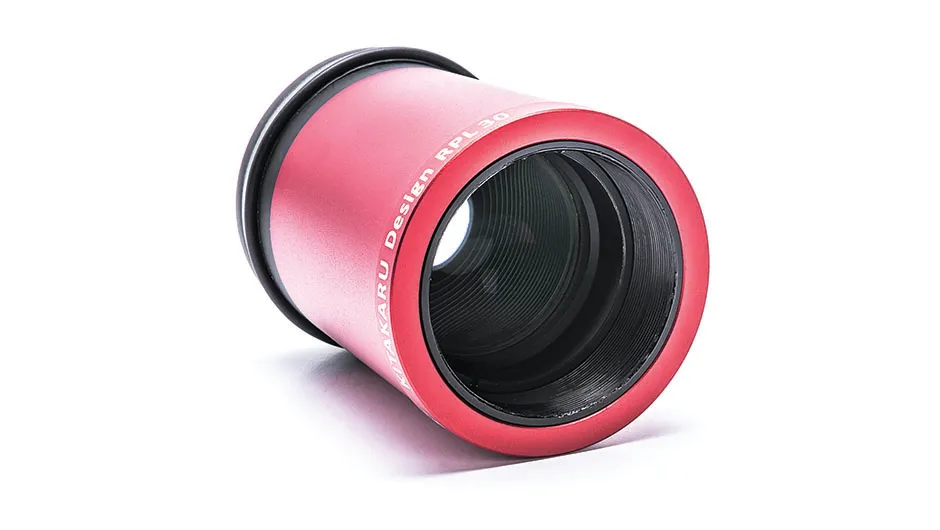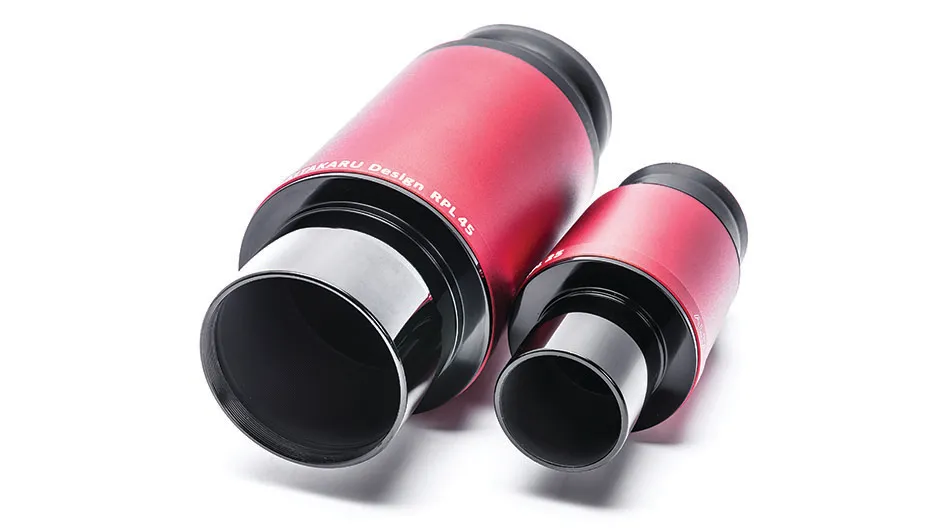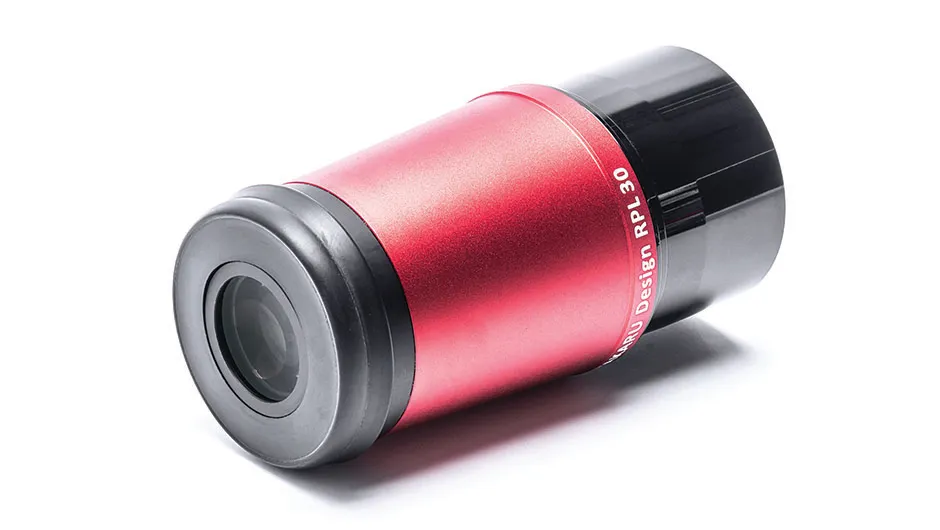There is a clear movement towards producing eyepieces with ever wider apparent fields of view, but in many cases this can be a distraction, taking your mind off the main event.Altair has taken a different approach with its trio of Kitakaru orthoscopic eyepieces, concentrating on a more modest apparent field but with long focal lengths to encompass a wide expanse of sky.
The eyepieces have focal lengths of 25mm, 30mm and 45mm.
The 25mm version has a 1.25-inch barrel and the other two have 2-inch barrels.
Each is finished in an electric red anodised coating over a lightly sandblasted and slightly conical body, with contrasting black trim and white lettering to indicate the focal length.

These oculars are designed for longer focal length telescopes so we used a 2x ED Barlow lens with our own 4-inch, f/6.5 refractor to produce an effective focal length of 1,238mm.
They are not fully parfocal, but a small focus adjustment was all that was required to refocus between eyepiece changes, making comparisons between each quick and easy.
Eye relief is the fixed distance from the curved surface of the outermost lens of an eyepiece to the point at which the exit pupil is formed.
The 45mm eyepiece had a much longer eye relief at 22mm than the two shorter focal length eyepieces and we didn’t suffer from any eye placement issues.
Colour control was excellent right out to the last 10 per cent of the field of view, where a small purple tinge started to appear on bright stars.
Star shapes were excellent to over 85 per cent of the field of view.
The field stop of the 45mm eyepiece was not quite as well defined as for the other two.
We used Aldebaran in Taurus as our test star and while in the region examined the huge Hyades star cluster, which was excellent in this eyepiece, as was the open cluster Melotte 20.
However, the Pleiades in Taurus and the Beehive Cluster in Cancer stole the show – we can safely say this is an excellent choice for observing open star clusters.

Slight variances
The 30mm eyepiece performed better in our star test with well-defined stars and colour control out to over 90 per cent of the field of view, with just a tinge of purple making its presence known at the extreme field edges.
The field stop was well defined with just a hint of a yellow tinge.
The galaxy duo of M81 and M82 in Ursa Major were a perfect fit and such a pleasure to see together so well defined.
M34 in Perseus was a treat and Orion’s Sword looked spectacular, but the highlight was our best ever view of the Double Cluster.
With the naked eye, the 15mm eye relief was fine but was more challenging when wearing spectacles even with the eyecup folded down.

The last ocular was the 25mm, a popular choice with manufacturers and many telescopes are supplied with one as standard.
These are generally of adequate quality but this one represents a big step up, providing excellent star shapes out to over 90 per cent of the field of view with excellent colour control, though again producing a slight purple tinge to stars at the very edge.
We couldn’t detect any difference in eye relief between this and the 30mm eyepiece (although at 14mm, it has the shortest relief of the eyepieces on test) and the field stop appeared very similar too.
We used it to observe Jupiter and its moons, and it produced a very crisp view, albeit at a very small scale.
However, it revealed the full field of the Leo Triplet of galaxies, the view of globular cluster M3 in Canes Venatici was excellent and the 2.5-day-old Moon showed exquisite detail.
These eyepieces didn’t disappoint but you should bear in mind that they are unsuitable for fast focal ratio telescopes unless you use a Barlow lens (for a refractor) or a coma corrector (for a reflector).
They’re best suited for intermediate observers, especially those with a Schmidt-Cassegrain or similar long focal length telescope.
Orthoscopic (producing an image with correct and normal proportions) eyepieces are so called because of their low levels of distortion, especially with regard to pincushion and barrel distortion.
Designed by Ernst Abbe in 1880, such eyepieces have four lens elements, but their disadvantage is that they produce a rather narrow apparent field of view, typically 40-45°.
This, however, is no impediment to lunar and planetary observing for which they have always been popular.
Altair’s Kitakaru eyepieces are a modified orthoscopic design, resulting in a much wider apparent field of view of 62° – and so maintaining some appeal for observers more used to wider fields.
The long focal lengths of these three eyepieces makes them less suitable for planetary observations but of more interest when observing larger celestial objects; they are also excellent for lunar observations when used with a long focal length telescope such as a Schmidt-Cassegrain.
They perform at their best when coupled to telescopes with slower focal ratios greater than f/7.
Sandblasted finish
Unusually there is no rubberised grip, a common feature to help with handling when wearing gloves, but the eyepiece body is finished in a sandblasted texture that gives it some grip.There is a small ridge just above the barrel, which also helps in this regard.
Fold-down eyecup
The soft rubber fold-down eyecups are a little utilitarian, but they did a good job of excluding extraneous light.We found that correct eye positioning was not at all critical and quite comfortable.The supplied rubber dust caps can be fitted when the eyecups are in either the folded down or up positions.
Multicoating and baffling
The lenses are treated with a nine-layer coating to reduce unwanted reflections and increase light transmission.The coatings are smoothly applied and display a greenish tinge with hints of violet in brighter ambient light.The inside of the eyepiece body is finished in micro baffles to further increase contrast.
Barrels
The 25mm eyepiece has a 1.25-inch barrel and the 30mm and 45mm eyepieces have 2-inch barrels, beautifully finished externally in a black gloss but finished internally with micro baffles and a well-applied matt finish.The removable barrels have a tapered profile and are internally threaded for filters.
Eye relief
The eye relief varies between the three eyepieces, with a generous 22mm for the 45mm variant, 15mm for the 30mm and 14mm for the 25mm.The 45mm is very suitable for spectacle wearers but the 30mm and 25mm are somewhat harder to use while wearing glasses; all three were fine without.
Vital stats
- Price £139.00
- Focal length25mm, 30mm, 45mm
- Supplier Altair Astro
- Telephone01263 731505
- Websitewww.altairastro.com
This review originally appeared in the June 2016 issue of BBC Sky at Night Magazine.
